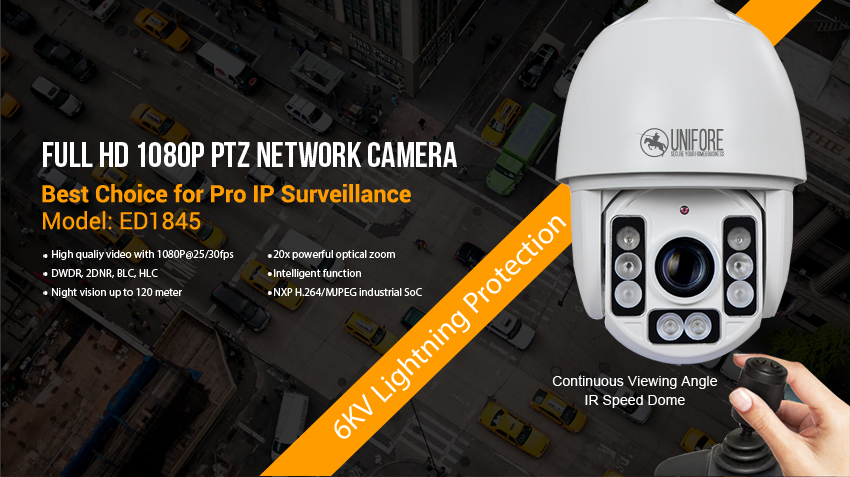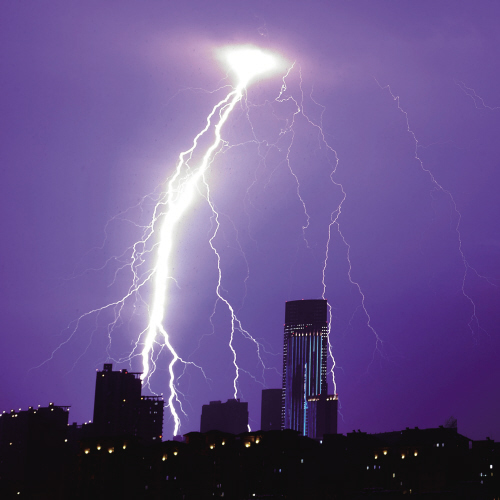
Tips/How to: lightning protection for your IP security cameras
Outdoor security cameras or closed-circuit television (CCTV) systems are increasingly being used as security tools to guard businesses, homes and other properties. Their effectiveness as a deterrent to crimes such as burglary, theft and vandalism has long been proven. But outdoor cameras are susceptible to such disturbances as lightning strikes and power surges that could cause major damage to the camera and other system components and compromise a home’s security.
There are, however, various strategies to decrease the possibility of major damage to the components of CCTV systems from such threats as lightning strikes and power surges. But before presenting them, let us first discuss some questions that should be asked before installing a CCTV system, as well as the basic components of the system.

1# Questions to be Asked Before Installing a System:
- Are there instances in the past in which the building was hit by lightning?
- Is the area where the building or property is located prone to power failures?
- Are there recorded occurrences of previous electronic failures and power issues in the building or site?
If you answered ‘Yes’ to any of these questions, then extra protection for the security cameras is needed.
2# Basic Components of Outdoor Security Systems:
Security Cameras
The camera is a device employed in the system to capture footage or images in a monitored space or property. There are three major types of cameras used in CCTV systems nowadays. The overt camera type is installed in areas that are visible to people to deter them from perpetrating crimes such as theft, vandalism or burglary. A covert camera is a type of camera that is installed in secret places like inside smoke detectors, wall clocks and stereo speakers, usually inside the home. A discreet camera is a type of camera installed behind a plastic dome and is chiefly employed in monitoring large areas and in observing workers or employees.
Monitors
The monitor is where the system operator sees the footage captured by the cameras. The size and number of monitors deployed chiefly depend on the number of cameras used in the system. Flat-panel liquid crystal display (LCD) monitors are usually used in CCTV systems.
Network Video Recorder (NVR)
The NVR is a consumer electronics device that is used to record videos in digital format to a hard disk drive. The size of the hard drive depends on the number of cameras recording and the length of time that the cameras are used to record footage. NVRs are typically available in 4-camera, 8-camera, and 16-camera options. The NVR can also be linked to a local area network (LAN) for remote viewing purposes on a smartphone or tablet.
These major components of a security system are all susceptible to possible damage in case of a power surge or lightning strike. So, how can one protect these components against said threats and avoid possible major costs of repair or replacement?
3# Effective strategies to protect outdoor security cameras:
Refraining from mounting or installing the camera to a metal structure to prevent the power from the lightning that could hit or affect the building where the system is mounted to reach the device. Lightning is most likely to strike a metal object over others.
- Making sure that the camera is properly grounded to the building’s structural steel as close to the camera as possible to reduce the risk of a power surge reaching the DVR through the coaxial cables. It is recommended that a 1 ½ inch copper strap connected to a ground rod is used as a ground connector.
- Utilizing a power panel with circuit breakers rather than individual power supplies for cameras to help minimize the damage that can be incurred due to power surges. It is recommended that power panels should be employed in conjunction with a surge protector and/or uninterrupted power supply (UPS) to achieve optimum protection for the system.
- Using a surge protector to prevent possible major damage to the DVR due to a power surge or transient voltage. A power surge is defined as the sudden sharp increase in voltage above the operating voltage in a specified area. The standard voltage in North America is 120 volts and 240 volts in other places worldwide.A power surge produces high heat that weakens the wires used in the system thus, decreasing their longevity. In the case of major surges, the wires can burst or burn, causing the system to fail. The surge protector prevents such possibilities by promptly recognizing a surge and redirecting the extra electricity to the grounding wire of the power outlet.
- Employing a UPS (Uninterrupted Power Supply) to protect the DVR against three major types of power abnormalities, namely, power surges, power lags and power failures. A voltage lag occurs when the power is below the standard voltage.
There are two main types of UPS used for DVRs. A Standby UPS enters into action only when it detects a power surge. It does not have sufficient protection against a voltage lag, so possible damage can still hit a DVR in case of a lag. A Continuous UPS powers the DVR using its on-board battery. The battery is also continuously being recharged. The continuous UPS ensures protection to the DVR against both power surge and voltage lag because it maintains standard voltage supply to the DVR at all times.
There are also other types of UPS available in the market today. The standby on-line hybrid UPS is similar to the standby UPS and is mainly used for devices below 10-kilovolt Ampere (kVA) capacity.
The Standby-Ferro UPS is chiefly intended for devices in the 3-15-kVA range. The UPS inverter is activated when the input power fails and the transfer switch is opened.
The Double Conversion On-Line UPS uses its inverter as the primary power path rather than the alternating current (AC) main. During input AC power failure, the transfer switch is not activated because the input AC is the backup power source rather than the primary source. The UPS is mainly used in applications more than 10-kVA.
The Delta Conversion On-Line UPS is similar in operation to the Double Conversion On-Line UPS. The UPS extra Delta Converter, also adds power to the inverter output. This type of UPS is applicable in the range of 5-kVA to 1-megawatt (MW).
Lightning strikes do happen! And even more common are power surges, lags and failures. Taking the precautions listed above along with some valuable safety hardware add-ons is essential to protecting your security cameras in case of lightning or other power related issues.
Get My Latest Posts
Subscribe to get the latest updates.
Your email address will never be shared with any 3rd parties.